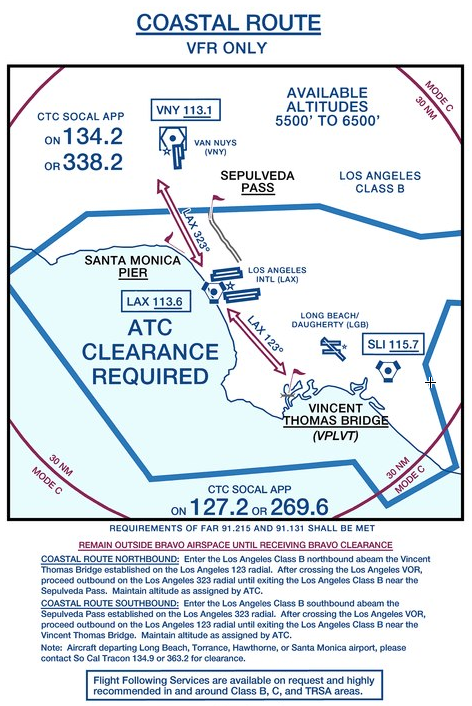CAT-10 Flight: Class B Transitions
Description
Conduct a flight from Camarillo Airport (KCMA) to John Wayne Airport (KSNA) utilizing the Coast Route through the Los Angeles Class Bravo Airspace.

Learning objectives
- Review radio communications when operating at Class D and C airports.
- Review basic VFR navigation skills.
- Review Class B Airspace
- Learn how to fly VFR Class B Transitions
Flying the Rating
To successfully complete this rating you must accomplish the following tasks:
- Fly from KCMA to KSNA via the published Coastal Route Class B transition.
- Inform ATC on initial contact at KCMA that you are performing the CAT-10 Rating.
- Meet the CAT Ratings Practical Test Standards
Airspace Review
This flight takes places within Class Delta, Echo, Bravo, Echo (again) and then Charlie airspace.
Class B Airspace
Class B airspace is the most restrictive airspace that VFR aircraft has access to and is located around the busiest airports in the country.
Aircraft operating in Class B airspace must obtain an ATC clearance prior to entering the airspace. Additionally, all aircraft operating in Class B airspace or within 30 NM of the primary Class B airspace must have and use a mode C transponder.
VFR Transitions
VFR transitions are coordinated routes through Class B airspace that allow VFR aircraft to easily transition the airspace. VFR transitions are published on VFR Terminal Area Charts. Examples of the published transitions include the Mini Route, Coastal Route, Hollywood Park Route and Coliseum Route.
Since VFR transitions go through Class B airspace, they require you to be in contact with ATC and to obtain a clearance. Note that unlike a VFR flyway, a transition consists of a very specific route to fly and altitude to maintain.
Normally once established on a VFR transition you will not be able to “leave” the transition early, you will need to fly the entire transition before resuming your planned flight.
The Coastal Route transition graphic is included in the rating, but you can reference the LAX TAC to review the other routes for future flights through the Bravo.
Class B Services
While operating within Class B airspace all aircraft are provided Class B services by the local approach control.
Class B services consist of traffic advisories, sequencing into the Class B airport, and separation between VFR and IFR aircraft (and certain larger VFR aircraft) operating in the airspace. All aircraft are automatically provided this service. Unlike with Class C airspace generally you cannot refuse Class B services.
Communications Review
In order to request a VFR transition you should contact the frequency listed for the transition on the VFR terminal chart.
When calling ATC state your callsign, aircraft type, location, altitude, and transition you are requesting.
ATC will provide a squawk code and once radar identified provide you a clearance through the Class B airspace via the requested transition.
Pilots can coordinate flight following to John Wayne while on the ground Camarillo, in the air with Mugu Approach, or air with Socal Approach. While it’s technically possible to simply call Socal Approach in the air to request the Coastal Route without providing final destination of John Wayne, since SNA is a Class C airport (which generally involves speaking with Socal Approach prior to the tower), and given the proximity of the end of the Coastal Route with the SNA Class C, it’s generally more efficient to keep the radar service after the Coastal Route to avoid having to initiate communications again when approaching the SNA Class C.
Note that in some cases ATC will not be able to accommodate this request, in this case you must remain clear of the airspace and find an alternate way to your destination (consider a VFR flyway).
Transcript
Class Delta departures and Class Charlie arrivals, and flight following has been reviewed in other ratings. Here is an example of a request for the Coastal Route for an aircraft which is already radar identified (ie, is receiving flight following):
N123AB: “Socal, N123AB request Coastal Route transition.”
Socal: “N123AB, Cleared into LAX Class Bravo airspace, proceed via the Coastal Route, maintain VFR at 5,500 while in the Bravo.”
N123AB: “Cleared into the Bravo via Coastal Route, maintain 5,500 in the Bravo, N123AB.”
ATC is required to inform aircraft when they depart Class Bravo airspace. So, towards the end of the route, expect to hear:
Socal: “N123AB, leaving the Bravo airspace, remain outside of the Bravo, contact Socal Approach 128.10.”
Cockpit Video
Related Material
VFR Communications Manual (commercial product) provides detailed guidance on ATC communications for VFR flights.
Airport Traffic Patterns (Wikipedia)
Web site containing scrollable, zoomable VFR and IFR charts
VFR Cruising AltitudesPilot’s Handbook of Aeronautical Knowledge – Navigation
FAA publication on basic and advanced VFR navigation skills.
VFR Flight Planning and Navigation Workshop
YouTube recording of a live workshop conducted by PilotEdge covering VFR flight planning and navigation methods.






